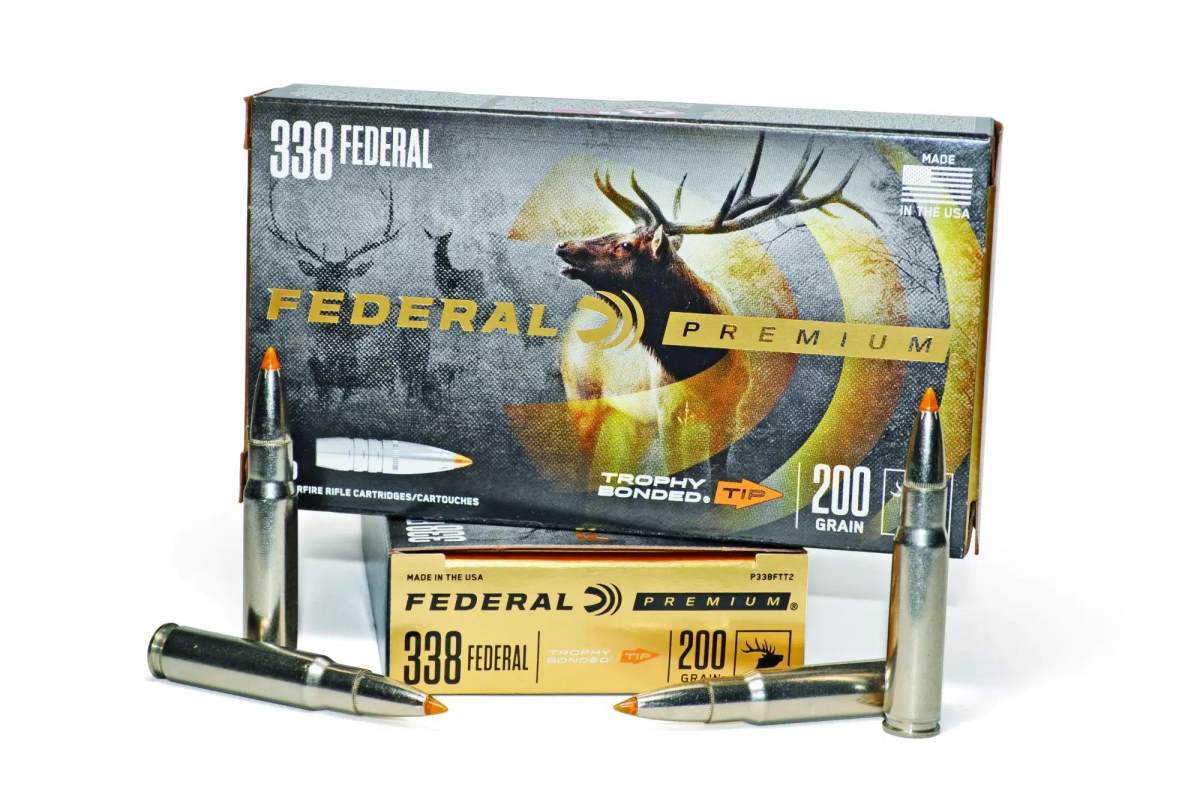
According to Allan, the short-action .338 Federal has proven itself as the 21st-century woods cartridge.
The .338 Federal grabbed my attention for two reasons. I’ve always had an appreciation for compact cartridges that seem to work well, and I found .338-caliber cartridges more interesting after we tested the wildcat .338-06.
I’ve heard it quipped that Federal conceived the .338 Federal cartridge so it could have a rifle cartridge with the company’s name on it. I find that rather dismissive. My standard is to ask if a cartridge plays well in a particular niche, and I had no trouble seeing where the .338 Federal played.
American hunters have a long tradition of “the woods cartridge.” This is usually a cartridge of low to modest velocity pushing big bullets for “busting brush.” Popular old-timers were the .33 Winchester, .35 Remington, and .348 Winchester, all popular in lever guns. Later entries included the .358 Winchester. Most owners considered anything over 150 yards “long.”
Theory says a big, modest-velocity bullet should be less upset by twigs and branches than a smaller high-velocity bullet. I’m unconvinced that is a valid position because of so many factors at play. Any bullet clipping a twig close to the muzzle before the bullet has “gone to sleep” is more likely to destabilize than one at over 100 yards. Yet a friend had a 180-grain .300 Win. Mag. bullet keyhole before hitting a kudu in open country at nearly 300 yards. Surprisingly, it hit the point of aim. Apparently, a bush or twig he could not see upset the bullet a few yards before striking.
The .338 Federal rolled out in 2006 as a refined version of the wildcat .338-08. The dimensions are slightly different, enough so that Federal’s Larry Head recommended I place a caution in Speer Reloading Manual #14, our first to show .338 Federal data. Head said that due to dimensional differences, .338 Federal factory ammo and cases should not be used in custom .338-08 rifles. We complied.
The .338 Federal has three bullet weights listed in current SAAMI guidelines: 180 grains at 2,830 fps; 185 grains at 2,750 fps; and 210 grains at 2,630 fps. With 200- to 210-grain bullets, only the old .348 Winchester (2,505 fps) and the relatively recent .338 Marlin Express (2,565 fps) come close. Federal’s current Web catalog shows only 200-grain loads loaded to 2,630 or 2,700 fps, depending on bullet style.
Maximum average pressure (MAP) is 62,000 psi, the same as the .308 Winchester. The .338 Federal continues a trend seen almost whenever we neck up an existing cartridge to hold a larger bullet: All other factors being equal, optimal reloading powders start to shift to the faster-burning side as bullet diameter increases.
Can handloading equal or exceed factory ammo? Not in early 2007 when we first developed data for Speer Reloading Manual #14. The propellant producing highest velocities with 200-grain bullets was Reloder 15. From a standard velocity test barrel (24 inches), its best velocity was about 2,600 fps—100 fps under the currently cataloged velocity for 200-grain factory loads
Fortunately, new components can change that. By the time the15th edition of the Speer manual came out in 2018, newer propellants like Alliant Power Pro Varmint and Hodgdon CFE 223 pushed the 200-grain Speer Hot-Cor Spitzer bullet to velocities that match factory nominal velocities. With the heavier Speer 225-grain BTSP, those same propellants, along with Alliant Power Pro 2000-MR, added more than 100 fps to what we could do in 2007. A 225-grain bullet at 2,550 fps is no slouch.
All in all, the .338 Federal offered no surprises in testing. Propellants “tracked” properly as we increased charge weights behind the two bullets we tested. Most propellants that do well in the .223 Remington are quite appropriate to the .338 Federal.
As with other compact cases, the .338 Federal demands a respect for bullet construction when looking up any load data. There are high-copper and all-copper bullets today that are far longer than their older conventional counterparts. They intrude deeper into the propellant space, requiring the propellant charge to be reduced in order to maintain safe pressures.
When we tested Trophy Bonded Bear Claw bullets (about 50 percent copper) in the .308 Win. for Speer Reloading Manual #14, we had to back off max charge weights for conventional jacketed bullets by up to three grains. The old assumption “bullets is bullets” is a lie and needs to be quickly buried in an unmarked grave. Use only data supplied by the bulletmaker, not your brother-in-law.
Although many riflemakers supported the .338 Federal at the time of its introduction, that number has dwindled. Today, a number of custom builders using the AR platform still offer it, but most of the bolt-rifle offerings are gone.
Whether this is an artifact of the current firearms purchasing push or a rejection of the cartridge, we’ll likely never know. To me the .338 Federal rightfully joins other fine woods cartridge. And in modern platforms it gives a little extra range for when a big buck steps out into a long open clearing. What convinced me? During development, Federal and Speer engineers teamed up to test the cartridge on Idaho elk. Experienced outfitters, who had seen a lot of animals shot and then run off, were greatly impressed with how effectively a cartridge they considered a deer round put down big bulls.
That told me a lot.






![Air gun 101: The differences between .177 & .22 – Which jobs they do best ? [Infographic]](https://airgunmaniac.com/wp-content/uploads/2020/09/g44-218x150.jpg)



































